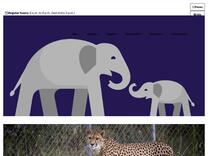Sloth Bears Updates Dec 19, 2013 | Smithsonian’s National Zoo and Conservation Biology Institute https://nationalzoo.si.edu/animals/news/sloth-bears-updates-dec-19-2013
Hank is a year old today! Hank now weighs about 125 pounds. His favorite foods are butternut squash, peanut butter, and grapes.
Hank and Hana share the same birthday so we will have a special birthday party to

